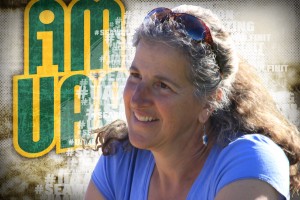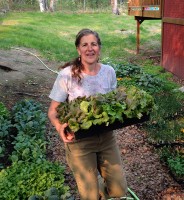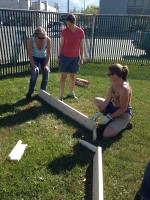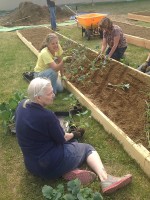Alumni Spotlight: Jan Newman
by Tracy Kalytiak |
Alumni Spotlight: Jan Newman M.A. Education, '90 Hometown: Palmer, Alaska Fun Fact: Jan earned her pilot's license after moving to Alaska in 1989.

UAA alumna Jan Newman founded Grow Palmer, a group that created a place called Edible Park, in Palmer. Photo by Heather Resz
The interplay between art and science has always fascinated Jan Newman.
"I view math and science as a kind of a language to define and describe the world," said Jan, who settled in Palmer more than 20 years ago after earning her master's degree at UAA. "The physics of sound and music, the physics of art, the physics behind the beauty of the world-that intrigues me."
Jan's love of science extends back to third grade, when her teacher engaged her with experiments using pulleys, inclines, things on wheels, forces of elastic bands. Jan loved watching small waves ripple in when she'd visit the beach, and the moon and its effect on tides entranced her.
Art captivated Jan as well. At 18, she molded sculptures and wove fiber creations after leaving her parents' Massachusetts home to attend a tiny Vermont college.
Soon, though, Jan felt something was wrong, askew. Her parents opened new places and cultures to Jan and her sister by bringing them to Europe, islands in the Pacific and on sailing adventures in the Caribbean. Many of her college's students, however, didn't share her thirst for exploration. They emerged from wealthy families and believed growth meant making a name for themselves by studying at Juilliard or Rhode Island School of Design, or breaking into the arts scene in Los Angeles or New York.
Jan felt she didn't fit. She wasn't sure she wanted to continue traveling her current path, wasn't sure she wanted to make a living in art.
"I was torn between two somewhat discrepant fields of study," she said.
Growing new perspectives
Jan moved to the coast of Maine, found a job driving a forklift in a lumberyard and moved into an inexpensive rental place in Machias. Then, by a nearby estuary, she built and lived in a cabin without running water or electricity, dug for clams outside her front door, planted a garden and supported herself in a series of seasonal jobs.
"I was always drawn to the wilderness and kind of remote settings, living off the earth," Jan said. "I tipped trees and pumped gas and raked blueberries and painted houses and cleaned chimneys. I just kind of liked the subsistence type of lifestyle, something a little bit more organic and accessible somehow on a deeper level. I consider myself having grown up there, because I became an adult there. I really kind of grew into the person that I am today during those years in Maine."
The seven years Jan spent in Maine motivated her to return to school. She traveled to Seattle and enrolled at the University of Washington. Her major? Atmospheric physics.

Jan Newman prepares to transfer flats of lettuce to the site of Edible Park, a garden Grow Palmer created in Palmer. Photo by Tracy Kalytiak
"I really appreciate having the tools to define the world scientifically, or mathematically, so physics was a nice fit for me," she said. "Atmospheric physics was really just something I fell into. When I was an undergraduate at UW, I connected with a woman, an oceanographer who was working with an atmospheric physicist, and they were looking at air-water interactions, the surface of capillary waves. That's just the direction I took."
Finding Alaska
As Jan worked to complete her bachelor's degree at UW, she realized Seattle was as close as she had ever lived to Alaska, a place she had long wanted to visit.
"I thought I would apply to a summer job in Alaska before returning to Maine," Jan said.
She applied for two jobs: helping with research at the Juneau Icefield and serving an internship with a seismologist at the Geophysical Institute in Fairbanks.
"I was offered both positions and, for some unknown reason, chose the job in Fairbanks," she said.
Jan journeyed to Alaska aboard a ferry to Skagway and met a woman who was coming up to Seward for the Mount Marathon race.
"She and I camped on the forward deck of the ferry and I gave her a ride to Anchorage," Jan said. "Oddly enough, I ran into her within the last year or two. She now lives in Palmer also, which is quite remarkable."
Jan arrived in Fairbanks and started working the next day. "I loved the job. It was doing something I'd never done before, " she said. "[The seismologist] had a project that he needed basically grunt work done, some data collection and digitizing and whatnot. He really didn't care how many hours I worked or when I worked, so long as the project was done by September when I was leaving."
Jan worked "four 12s" each week and explored Alaska three days a week.
"I went everywhere," she said. "I went to Southeast, to the Brooks Range, to McCarthy. I didn't ever really get out into the Bush-Nome or Dillingham or any of those places- but anywhere you could go on the road system, like Gulkana, Delta, the Denali Highway. I drove all the highways."
What was Alaska's appeal?
"I think it was just sort of that frontier mentality that Alaskans tend to have and the fact that there are no pretenses-people are exactly as they present themselves," Jan said. "You don't have to dress a certain way or act a certain way. I also learned that some of my own biases or prejudices really do not stand up in Alaska. You can look at something from the outside and think one thing and then you explore a little further and discover it's something entirely different."
One of Jan's many road trips highlighted this for her. She remembers driving by herself, possibly somewhere outside Tok. She felt really hungry and wanted to stop to eat.
"But all's I saw was this somewhat ramshackle, dilapidated building that said 'café' on the outside," she said. "It looked a little dicey, wasn't really sure I wanted to go in there by myself. But it was the only place I'd seen for miles, so I stopped. Inside was a lovely little quiet restaurant with delightful people. I made conversation and learned about some wonderful places to go visit on my way. It just kind of struck me as, never judge a book by its cover."
Knitting a diverse life
Jan returned to Seattle to finish her studies. She had originally intended to graduate and head back to her cabin in Maine. Instead, she started attending ground school at Boeing Field and plotted a new course for her life: attending graduate school in Alaska.
She decided to earn her master's degree at UAA rather than returning to Fairbanks, and chose to study education.
"UAA is the school that had the education program so it was a perfect fit there," she said. "I really was not interested in theoretical physics and needed something more hands-on and accessible in the real world. Teaching seemed like it would be a good fit for me. I wanted to learn to fly; in the summer, I could take flying lessons. I traveled the entire road system of the state, but flying was the way to go to see the rest of Alaska."
Jan loaded up her dog and cat and drove the Alcan back to Alaska after receiving her diploma. She resumed flying lessons, at Merrill Field, and talked to an advisor at UAA.
"She was a wonderful woman, just dynamite," Jan said. "She looked at all my school experiences at University of Washington and experiences prior to that. I was not a typical 22-year-old graduate student. She was really great steering me toward work I wanted to do, classes that would nurture the type of teaching environment I was interested in-I really wanted to teach middle school because I identified with a child who was not quite a child, not quite an adult."
Jan completed her student teaching at Hanshew Middle School and then taught at Wendler Middle School.
"There were a lot of multicultural classes I took at UAA that were really helpful," she said. "I wanted to learn about Alaska Native villages in the Bush and was interested in cultures and languages anyway. Those and some anthropology classes were really good."
While in school, Jan worked as a layout artist for Mat-Su's Frontiersman newspaper. She had taken judo on and off for years, found a dojo in Anchorage and met another student who appeared to be quite advanced.

Jan Newman and Grow Palmer volunteers prepare to make raised beds for Edible Park. Photo by Tracy Kalytiak
Tom Newman had grown up in Hawaii, moved to Alaska as a child and stayed to attend school after his family moved away. He earned his bachelor's degree at UAA and, later, earned his master's degree at the University of Washington and went on to found TerraSond Ltd., an international underwater, land and geophysical surveying and mapping company based in Palmer that conducts oil and gas work and charts for the National Oceanic and Atmospheric Administration. Tom also serves on UAA's Geomatics Advisory Board and UAA's hiring committee for the surveying department.
At that dojo back in 1990, Tom and Jan struck up a conversation after class and connected.
"Our first date we went skiing up Flattop," Jan said. "We went to dinner afterwards at Mexico in Alaska, and talked for hours and hours."
They married a year and a half later, began building a home on Lazy Mountain near Palmer and had a son, Riley, followed by daughters Mariah and Kearney. The Newmans traveled, sailed, homeschooled their children and raised alpacas.
"My first child was 2 years old in 1994 and Tom and I were living here in Palmer," Jan said. "I realized it is very difficult to find natural-fiber clothing for small children-most everything is polyester and synthetic and I like to wear cotton and silk and wool in the winter. So I taught myself how to knit and made my son a sweater, long johns and a hat. One thing led to another and eventually I had alpacas."
Something everyone needs
Last year, Jan became an "empty nester" after her youngest daughter traveled to Thailand to become an exchange student. She wanted to do something in the community and saw a TED Talk about urban agriculture.

Jan Newman and Grow Palmer volunteers plant seedlings at Edible Park, in Palmer. Photo by Tracy Kalytiak
"It seemed to be a perfect idea for me and for Palmer," she said.
Jan approached Palmer's mayor, DeLena Johnson, as well as the city gardener, director of public works and the city manager and obtained a letter of support that helped her new organization, Grow Palmer, obtain a $6,000 Mat-Su Health Foundation grant and another $2,500 from local businesses. She planted edible gardens at two places in Palmer and used signs to encourage people to harvest the food.
"People tend to think public plantings are hands-off, no touching," she said. "I heard a woman say, 'Do you think they really mean it?' Everybody caught on and by the end of the year we harvested what remained, celery and parsley, which we donated."
This year, Jan won a $15,000 grant from Mat-Su Health Foundation, a matching grant from the Mat-Su Borough and a grant from Valley Garden Club, as well as support from Matanuska Valley Federal Credit Union, Sustainable Design Group and donations of plants from home gardeners, for Edible Park, a garden of vegetables and edible flowers to be planted in a lot behind Palmer's Salvation Army building.
Grow Palmer volunteers built Edible Park's garden boxes, filled them with Susitna Organics soil and planted stripe and checkerboard patterns of seedlings. Alaska Job Corps students crafted picnic tables, so passers-by can sit to eat the lettuce, chives, collards, nasturtiums, broccoli, cabbage and other veggies they snip with scissors leashed to the boxes. Signs by the beds instruct people how to harvest so the plants can continue to grow.
"When you work with community volunteers, you meet a breadth of people in a community that you never knew were there," Jan said. "A project takes on a momentum of its own [when] people are willing to take on parts. You can't have a rigid vision of what it's going to be-the community steers the project."
Jan plans to install a rain-catchment system for Edible Park this week. She says a market board in downtown Palmer gives information about where people can find local meat, eggs, honey, preserves and cheese.
Why are Edible Park and locally sourced food so important?
"Food is something everybody needs," Jan said. "It spans age, religion, culture, gender-we all eat, it's all inclusive. Alaska is highly dependent on outside sources of food. The more sustainability we create, the better."
Written by Tracy Kalytiak, UAA Office of University Advancement
 "Alumni Spotlight: Jan Newman" is licensed under a Creative Commons Attribution-NonCommercial 4.0 International License.
"Alumni Spotlight: Jan Newman" is licensed under a Creative Commons Attribution-NonCommercial 4.0 International License.














